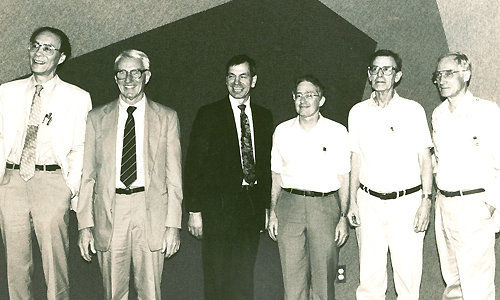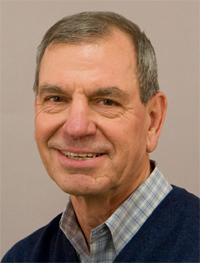By Jean Andrews
Physics & Astronomy
Dr. Lawrence Crum ‘63BS, ‘65MS, ‘67PhD remembers collecting stray golf balls along the Hocking River to help support himself and his young family. An Ohio University physics graduate student under Professor Emeritus Burt Stumpf’s tutelage in the late 1960s, Crum was on his way from his childhood farm without electricity to a laboratory where he would convert sound into light.
“I lived next to the golf course and in the evenings, sometimes I would walk along the river and pick up golf balls that were hit into the water,” he explained. “I found over 2,000 balls and sold them for a quarter apiece to the local sports store—the owner put out a barrel of them and sold them for 50 cents or a dollar. Since tuition was only $200/semester (or some small number like that), I generated quite a significant income.”
The golf balls helped get him through graduate school, but it was a single bubble trapped in an acoustic wave with the power to melt atoms that shaped his career. Since producing that stable bubble emitting light in a sound wave in 1989, Crum has turned his energy toward using sound—ultrasound—in medical treatments such as kidney stones.
Since graduating from Ohio University with a Ph.D. in Acoustics, Crum’s academic journey has led him to important discoveries and inventions in physical and biomedical acoustics. According to the Acoustical Society of America (ASA), Crum’s early research at the University of Mississippi involved bubble dynamics, mass transfer, and radiation stress. Later his focus became the physical effects of high-energy cavitation in both the physical and biomedical contexts. This was followed by the discovery of single-bubble sonoluminescence, his seminal work in bubble-related acoustical oceanography, and his eventual immersion in the exciting new field of high-intensity ultrasound therapy and related applications. The potential implications of sonoluminescence—that a bubble can collapse so violently that atoms can fuse—was even debated on the floor of Congress.

Dr. Lawrence Crum (third from left), returns to Athens on October 15, 1992, to receive the Ohio University College of Arts and Sciences Significant Achievement Award. Ohio University Physics Professors include (L to R) Charles Chen, Burt Stumpf, (Lawrence Crum), Roger Rollins, Ed Sandford, and Charles Brient.
In 1992, Crum returned to Athens to accept the Ohio University College of Arts & Sciences Significant Achievement Award. That same year he accepted a senior research position at the University of Washington Applied Physics Laboratory. There he developed a multi-faceted and highly successful program incorporating elements of bubble-related physical acoustics, acoustical oceanography, and biomedical ultrasound. Crum founded the Center for Industrial and Medical Ultrasound (CIMU), a center devoted to basic and translational research in biomedical ultrasound.
Crum’s contributions have been widely recognized by his colleagues in the United States and abroad. He was a Fulbright Fellow in 1985, was named Honorary Visiting Professor of Chongqing University, Honorary Foreign Professor of Physics at Moscow State University in 2002, and Honorary Visiting Professor at Nanjing University in 2010, and was awarded the Distinguished Service Medal of the Civilian Research and Development Foundation in 2005. In 2009, he was elected to membership in the Danish Academy of Natural Science. Among his most cherished awards are the Acoustical Society of America’s (ASA) Helmholtz-Rayleigh Interdisciplinary Silver Medal (2000), the ASA Student Council Outstanding Mentor Award in 2006.
Crum is Principal Physicist and Founder and Former Director of CIMU, as well as Research Professor of Bioengineering and Electrical Engineering at the University of Washington. He also works part-time as President of UltraSound Technologies Inc., a company he founded in 2001. He has held previous positions at Harvard University, the U.S. Naval Academy and the University of Mississippi, where he was F. A. P. Barnard Distinguished Professor of Physics and Director of the National Center for Physical Acoustics. He has published more than 300 articles in professional journals and holds an honorary doctorate from the Universite Libre de Bruxelles. He is President of the International Society for Therapeutic Ultrasound and Past President of the Acoustical Society of America and of the Board of the International Commission for Acoustics. His principal areas of interest are therapeutic ultrasound, physical acoustics, and image-guided therapy.
In June, Crum received the AS A’s highest honor, the Gold Medal, at its meeting in Montreal, Canada. The Society members recognized “his exceptional contributions to the science and technology of acoustics, his leadership within the ASA and the international scientific community, his vision and commitment to important translational research, and the profound impact he has had on the lives of countless students and colleagues.”
Crum traces the direction of his life’s work and passion for the study of acoustics back to Ohio University and the mentorship of Professor Stumpf.
“Dr. Stumpf…cared very much about his graduate students and wanted us to succeed. He loved the Acoustical Society of America and asked me to become a student member when I joined his laboratory. He also felt that I ought to know the leading researchers in my field, so he asked me, during my later years of graduate school, to select one of the leading areas of research in acoustics and the principal researcher in this area and write a little about the topic and the person…and then to repeat this activity nearly every week. I fell in love with the ASA and I think that those investigations were largely responsible for my receiving the Gold Medal.
“I grew up on a rural farm, with no electricity until I was 7 and no indoor plumbing until I was in high school, yet the whole world was open to me if I could get an education. Burt Stumpf gave me the opportunity to excel in a field that allowed me to achieve some level of prominence….I owe him a great debt.”




















Comments